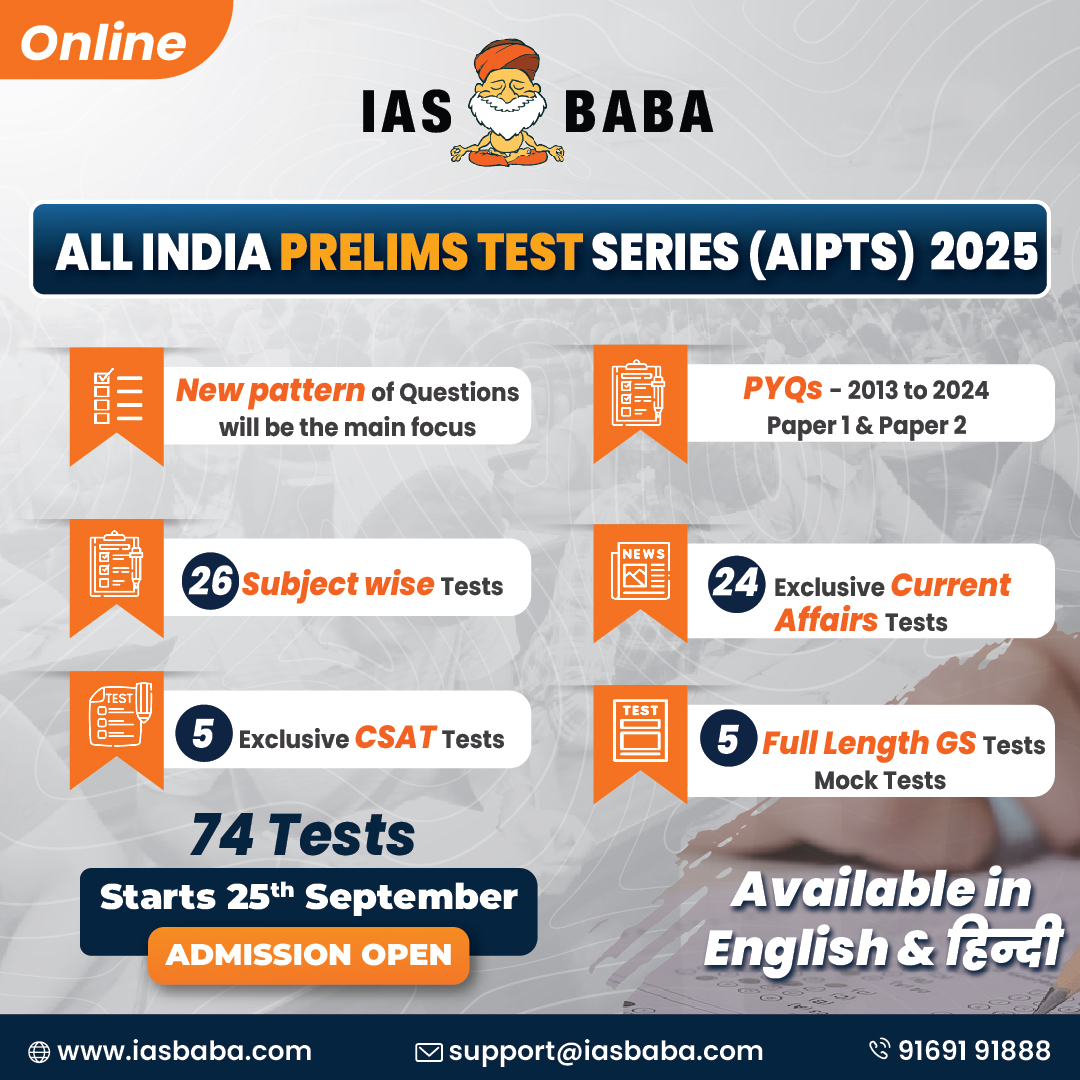IASbaba's Daily Current Affairs Analysis
Archives
(PRELIMS + MAINS FOCUS)
Increase in India’s trade deficit
Part of: Prelims and GS-III Economy
Context: As per preliminary foreign trade estimates, India’s merchandise exports rose 22.3% to $33.81 billion in February, while imports shot up 35% to surpass $55 billion, increasing the trade deficit to $21.2 billion.
Do you know?
- A trade deficit is an economic measure of international trade in which a country’s imports exceeds its exports.
(Trade Deficit = Total Value of Imports – Total Value of Exports)
News Source: TH
Ahom warrior Lachit Borphukan
Part of: Prelims and GS-I History
Context: President Ram Nath Kovind recently launched the 400th birth anniversary celebrations of Ahom general Lachit Borphukan.
- He also laid the foundations for Alaboi war memorial and a 150-foot bronze statue of the legendary commander.
- Lachit Borphukan was a legendary army commander of the Ahom kingdom.
- He is known for his leadership in the 1671 ‘Battle of Saraighat’ on the Brahmaputra against Mughal forces where he defeated the Mughal army.
- Earlier, The Battle of Alaboi was fought on August 5, 1669, between the Ahoms and Mughals where Mughals had won.
About Ahom kingdom (1228-1826)
- It was a late medieval kingdom in the Brahmaputra Valley in Assam.
- The kingdom is well known for maintaining its sovereignty for nearly 600 years and successfully resisting Mughal expansion in Northeast India.
- It was established by Sukaphaa, a Tai prince from Mong Mao
News Source: IE
Global additive manufacturing
Part of: Prelims and GS-III Economy
Context: The Ministry of Electronics and Information Technology (MeitY) aims to increase India’s share in global additive manufacturing to 5 per cent within the next three years.
- It is also hoped that it could likely add $1 billion to the gross domestic product by that time.
Key takeaways
- As per the National Strategy for Additive Manufacturing, by 2025, India will aim to achieve certain targets such as:
- 50 India specific technologies for material, machine and software,
- 100 new startups for additive manufacturing,
- 500 new products.
- In total, MeitY hopes that these new startups and opportunities will give jobs to at least 1 lakh new skilled workers over the next three years.
About additive manufacturing
- 3D printing or additive manufacturing uses computer-aided designing to make prototypes or working models of objects by laying down successive layers of materials such as plastic, resin, thermoplastic, metal, fiber or ceramic.
- With the help of software, the model to be printed is first developed by the computer, which then gives instructions to the 3D printer.
News Source: IE
(News from PIB)
Launch of e-Bill processing system
Part of: GS-Prelims and GS-II: Governance
In News: Union Minister for Finance & Corporate Affairs Smt. Nirmala Sitharaman launched the Electronic Bill (e-Bill) processing system, announced in Union Budget 2022-23.
- Part of ‘Ease of Doing Business (EoDB) and Digital India eco-system’ to bring in broader transparency and expedite the process of payments.
What is e-Bill processing system?
- The e-Bill Processing System is a step towards enhancing transparency, efficiency and a faceless-paperless payment system. Now suppliers and contractors will be able to submit their claims online, which will be tracked on real-time basis.
- In simpler terms, e-Billing is a way of transacting bills digitally rather than the traditional use of paper. Customers can get their bills online, via email, or in machine-readable data forms when billed electronically.
- As e-Billing is time efficient, this would be a quick and simplified way better fitted to the government’s call for making India digital. It would also reduce errors.
The e-Bill system has been rolled out on a pilot basis in eight ministries. It will be implemented in all ministries and departments in a phased manner in 2022-23.
News Source: PIB
Flagging off of Jan Aushadhi Rath, Jan Aushadhi Mobile Vans and Jan Aushadhi E-rickshaws to raise awareness
Part of: GS-Prelims and GS-II: Issues relating to development and management of Social Sector/Services relating to Health
In News: The Jan Aushadhi Rath will travel 7 days covering 4-5 States and Vans and E-rickshaws will travel across Delhi up to 7th March to raise awareness at the grassroot level about the benefits of the Pariyojana and Jan Aushadhi generic medicines which are available at affordable prices for all.
About Jan Aushadhi Yojana
- Rationale: It is a well-known fact that branded medicines are sold at significantly higher prices in India. Given the widespread poverty across the country, making available reasonably priced quality medicines in the market would benefit everyone, especially the poor and the disadvantaged.
- Under the: Department of Pharmaceutical’s Bureau of Pharma PSUs of India (BPPI), under the Ministry of Chemicals & Fertilizers.
- Vision: To bring down the healthcare budget of every citizen of India through providing “Quality generic Medicines at Affordable Prices”.
Mission
- Create awareness among the public regarding generic medicines.
- Create demand for generic medicines through medical practitioners
- Create awareness through education and awareness program that high price need not be synonymous with high quality
- Provide all the commonly used generic medicines covering all the therapeutic groups
- Provide all the related health care products too under the scheme
Aim: To widely provide generic medicines to people across the country to make healthcare more affordable.
- Pradhan Mantri Janaushadhi Kendra is a medical outlet opened under the scheme which makes quality medicines available at affordable prices for all.
- “Jan Aushadhi Sugam” mobile app helps in locating nearest Janaushadhi Kendra and availability of medicines with its price.
- These centres across the country would also provide 75 Ayush medicines
What exactly is the difference between a generic drug and brand- name drug?
- When a company develops a new drug — often after years of research — it applies for a patent, which prohibits anyone else from making the drug for a fixed period. To recover the cost of research and development, companies usually price their brand- name drugs on the higher side.
- Once the patent expires, other manufacturers duplicate and market their own versions of the drug.
- Since the manufacture of these generic drugs do not involve a repeat of the extensive clinical trials to prove their safety and efficacy, it costs less to develop them. Generic drugs are, therefore, cheaper.
However, because the compounds in the generic versions have the same molecular structure as the brand-name version, their quality is essentially the same. The generic drug has the same “active ingredient” as the brand-name drug. This ingredient is the one that cures the patient; and other, “inert ingredients”, which give the drug its colour, shape or taste, vary from the brand-name drug to the generics.
- The prices of generic medicines are much cheaper than their branded equivalent.
- The generic drug does not have to undergo a complete clinical trial to be proved equivalent, the bioequivalence test is much cheaper than clinical trials making generic drugs cheaper.
- The government’s move assumes significance as medicines account for 70-75% of a household’s out of pocket expenditure on health
- The move will result into affordable access to quality medicines which is a part of free universal access to healthcare services.
- India being a world leader in generics, the dependency on imports of patent drugs will reduce improving our trade of balance.
News Source: PIB
(Mains Focus)
ENVIRONMENT/ GOVERNANCE
- GS-2: Government policies and interventions for development in various sectors.
- GS-3: Conservation, environmental pollution and degradation
IPCC New Climate Report
Context: The latest warnings have come in the second part of IPCC’s Sixth Assessment Report which talks about climate change impacts, risks and vulnerabilities, and adaptation options.
- The first part report was released in August 2021 and third (final part of the report) is expected to come out in April 2022.
- The Assessment Reports, the first of which had come out in 1990, are the most comprehensive evaluations of the state of the earth’s climate.
- The four subsequent reports were released in 1995, 2001, 2007 and 2015 which have formed the basis of the global response to Climate Change.
- The Paris Agreement, negotiated on the basis of the Fifth Assessment Report, seeks to keep the rise in global temperatures “well below” 2°C from pre-industrial times, while “pursuing efforts” to limit it to 1.5°C.
- These reports, on their own, are not policy prescriptive: They do not tell countries or governments what to do. They are only meant to present factual situations with as much scientific evidence as is possible.
What does the latest IPCC report say?
- Sectoral & Regional Assessment: The latest report has for the first time, made an assessment of regional and sectoral impacts of climate change.
- Granular information: It has included risks and vulnerabilities of, mega-cities around the world. For example, it has said Mumbai is at high risk of sea-level rise and flooding, while Ahmedabad faces serious danger of heat-waves.
- Health Impact: Also for the first time, the IPCC report has looked at the health impacts of climate change. It has found that climate change is increasing vector-borne and water-borne diseases such as malaria or dengue, particularly in sub-tropical regions of Asia.
- It has also said deaths related to circulatory, respiratory, diabetic and infectious diseases, as well as infant mortality, are likely to increase with a rise in temperature.
- Inadequate action: It points out that the rise in weather and climate extremes has led to some irreversible impacts as natural and human systems are pushed beyond their ability to adapt. Also, most of the targets that countries have set for themselves are too far in the future to have an impact in the short term.
- Urgency of Adaptation: The report has said that while strong actions to reduce greenhouse gas emissions in the near term, in the next 20 years, would substantially reduce the threats, and the projected damages, they would not eliminate them all. The need to take adaptation measures is therefore very important, the report has stressed.
Why has IPCC stressed on adaptation?
- Climate change adaptation means altering our behavior, systems, and—in some cases—ways of life to protect our families, our economies, and the environment in which we live from the impacts of climate change.
- The report has said the gaps in adaptation was a result of lack of funds and political commitment, and also the absence of reliable information and a sense of urgency.
- It has pointed out that there were “feasible and effective” adaptation but the effectiveness of these options decreases sharply with further increases in temperature.
- Adaptation is essential to reduce harm, but if it is to be effective, it must go hand in hand with ambitious reductions in greenhouse gas emissions
IPCC report and India
- Noting that over 3.5 billion people, over 45% of the global population, were living in areas highly vulnerable to climate change, the report identifies India as one of the vulnerable hotspots.
- Lucknow and Patna are among the cities predicted to reach wet-bulb temperatures – an index of the impact of heat and humidity combined – of 35°C while Bhubaneshwar, Chennai, Mumbai, Indore, and Ahmedabad are at risk of reaching wet-bulb temperatures of 32°C-34°C with continued emissions. This will have consequences such as a rise in heat-wave linked deaths or reduced productivity.
- Extreme weather led to cereal production loss of 9-10 % (1964-2007). In India, rice production may decrease 30% and maize production will decrease 70%, if global warming over pre-industrial levels rises to 4°C from 1°C, the IPCC analysis found.
- With higher emissions, and if ice sheets collapse more quickly than expected, sea levels could rise as much as 2 metres this century and 5m by 2150. India is one of the most vulnerable countries in terms of the population that will be affected by sea-level rise.
- By the middle of the century, around 35 million of its people could face annual coastal flooding, with 45 million-50 million at risk by the end of the century if emissions are high.
Connecting the dots:
- IPCC’s Sixth report (First part) on Climate Change & India
- Paris Climate Deal: India’s Progress, Pandemic and Challenges
POLITY/ GOVERNANCE
- GS-2: Federalism and Challenges
Deputation of DIGs: Proposed Changes
Context: After its proposal to amend the All India Service Rules that would allow it to call any IAS, IPS or IFoS officer on central deputation with or without the state’s consent, the Centre has issued another order on central deputation of Deputy Inspector General-level IPS officers.
What is the order?
- According to existing rules, a DIG-ranked IPS officer with a minimum experience of 14 years could only be deputed to the Centre if the Police Establishment Board empanelled them as DIGs at the Centre.
- The board chooses the panel on the basis of officers’ career and vigilance records. Only Superintendent of Police (SP) level officers do not require empanelment at the Centre.
- In an order issued on February 10, the Department of Personnel and Training (DoPT) has said that IPS officers coming to the Centre at DIG level would no longer be required to be empanelled at that level with the Union Government.
- The new order makes the entire pool of DIG-level officers in a state eligible for central deputation.
Why has it been issued?
- Sources in the Ministry of Home Affairs (MHA) said the move is aimed at increasing the pool of DIG-level IPS officers for central deputation in the backdrop of massive vacancies in central police organisations (CPOs) and the Central Armed Police Forces (CAPFs).
- According to data sourced from various CPOs and CAPFs, out of 252 posts reserved for IPS officers at DIG level at the Centre, 118 (almost half) are vacant. IPS officers have a quota of 40% in CPOs and CAPFs.
How will the move help?
- According to MHA sources, the idea is to ease up the process of central deputation as verification of records takes a long time (sometimes as long as one year)
- Also, it increases the size of the pool of officers available to the Centre.
- However, this would not automatically allow DIGs to come to the Centre. Officers would still have to be put on the offer list for central deputation which is decided by the states and the Centre in consultation. Also, states would have to be willing to relieve them.
So why would states have a problem?
- If read with the recent proposal on deputation of IAS, IPS and IFoS officers, the new order may be seen by many states as the Centre’s attempt on increasing its powers over officers serving in the states.
- Under the earlier proposals, the Centre would have powers to demand, within a stipulated time frame, a certain quota of officers from the state for central deputation, and also to call any IAS officer on central deputation in “public interest”. In case the state failed to relieve the officer, he/she would be deemed relieved following the date fixed.
- Most states, including some ruled by the NDA, have opposed the move.
- Also, there is little evidence of a waiver of empanelment conditions having an impact on vacancies at the Centre. For example, there is no requirement of empanelment for SP level posts, yet the vacancies are close to 50%.
Why don’t states relieve officers?
- Because there is a serious paucity of officers in the states too.
- In a cost-cutting move during the Atal Bihari Vajpayee regime, the size of IPS batches among other government staff was reduced even though sizeable vacancies existed even then.
- From 80-90 officers each, IPS batches were cut to 35-40 officers (in 1999-2002, the average was 36). The average attrition rate of IPS officers due to superannuation is 85 per year.
- While the number of districts in some states doubled in a decade or so, the availability of officers was one third.
- In 2009, against a sanctioned strength of over 4,000 IPS officers, there were more than 1,600 vacancies. During UPA government, the government began intake of IPS batches as large as 150.
- The government has continued to increase the size of batches with the 2020 Civil Services Exams taking in 200 IPS officers.
- According to the MHA, as on January 1, 2020, there were 908 vacancies against a sanctioned strength of 4,982.
- The strength of IAS officers too had been impacted due to low intake during the 1990s.
How has this impacted the services?
- The anomaly in IPS recruitment adversely affected cadre management over the years. At some levels, there are fewer officers than sanctioned posts, while at others there is a glut.
- On one hand, states are not providing enough DIGs or SPs to the Centre, while on the other, the Centre does not have enough posts if the total cadre reserve of IPS is calculated.
- Uttar Pradesh has a shortage of DIGs and IGs, but too many officers at the level of ADGs.
- Then while states should ideally promote batches or parts of it according to the vacancies available, political bosses often promote entire batches to please a certain section, in effect slamming doors on promotional avenues for those below them.
- CAPF officers, themselves facing career stagnation, have been demanding removal of the DIG-level quota for IPS officers as they are unwilling to join, so that
force cadre officers can instead fill these posts. - It is estimated that by 2025, states may have surplus officers at DIG level to spare for the Centre and, if Centre-state relations remain normal, the issue may be resolved.
Connecting the dots:
(Sansad TV: Perspective)
Feb 23: The Crypto Question – https://youtu.be/WHZVecBPGRg
TOPIC:
- GS-3: Indian Economy and issues relating to planning, mobilization, of resources, growth, development and employment.
- GS-3: Science and Technology- developments and their applications and effects in everyday life.
The Crypto Question
Context: While Bitcoin started more than a decade back in 2008, total market capitalisation of all cryptocurrencies was only $20 billion in early 2017. This went up to $289 billion in next three years and thereafter exploded to reach a peak of $2.9 trillion in November 2021. In the last three months it has again witnessed a sharp decline.
- As of today the total number of cryptocurrencies is at 17,697 and the total number of crypto exchanges is 462.
- Currently, there is no regulation or any ban on the use of cryptocurrencies in India.
- The Reserve Bank of India’s order banning banks from supporting crypto transactions, was reversed by the Supreme Court order of March 2020.
- While the RBI has repeatedly underlined its strong view against cryptocurrencies, saying these pose a serious threat to the macroeconomic and financial stability of the country, Govt. of India is working on a legislation for regulation of this sector.
Budget 2022
- Finance Minister in her Budget speech this year has proposed to introduce a digital currency in the coming financial year for which RBI is soon expected to carry out pilot studies.
- Removing all doubts on whether cryptocurrencies would become a legal tender or a medium of exchange in the future or not, the budget clarified that the Government of India doesn’t consider cryptocurrency as a currency, but shall treat it as a virtual digital asset. In other words, the Government of India would treat cryptocurrency as an investment.
- While presenting the Union Budget 2022 government proposed a tax of 30 per cent on virtual assets, effectively legitimizing trading of private cryptocurrencies and non-fungible tokens. This is broadly in line with the Centre’s plans to have a fiat digital currency, while disallowing use of private virtual coins as legal tender.
Taxing Transactions in Cryptocurrencies
The power to levy taxes is prescribed under Article 246 which grants power to the Parliament as well as state legislatures to impose taxes. Article 265 provides that no tax can be imposed or collected without the authority of law. Today, with the rise of cryptocurrencies and its underlying technology, the world stands at the helm of another such revolution. Cryptocurrencies like bitcoin are decentralised, digital currencies relying on a peer-to-peer network which operates without the need for a third-party intermediary like the Reserve Bank of India. Coupled with lack of regulatory guidance, its unique technical aspects create huge complications in its taxation.
- These clarifications about taxation of cryptocurrencies aka virtual digital assets, as the government wants it to be addressed, come at the right time.
- It especially becomes extremely important because around 10 crore individual investors have invested around Rs 6 lakh crore in various cryptocurrencies, as per the advertisement issued by The Blockchain and Crypto Assets Council which is a part of the Internet and Mobile Association of India.
- The taxing of ‘virtual digital assets’ or crypto currencies will help the Income-Tax department measure the “depth” of this trade in the country.
- The income-tax department and the income-tax Act only looks at whether the transactions that you have entered into are resulting in income.
- Taxing crypto currency under the new legislation does not attach any legality.
- When an entity declares any profit or surplus on the digital trade, then they also have to say where they have got the money to invest from and, if the investment is proper and justified, then the surplus will be taxed.
- The taxation will also help us know if the investment is contaminated or illicit, if he/she is putting unaccounted income or it is a ‘benami’ of somebody else, then the consequences will follow.
Challenges:
- Absence of explicit tax provisions has led to ambiguity and uncertainty: Lack of clarity as to whether the GST on crypto transactions is applicable only on Rupee transactions alone or even on transactions through crypto currencies.
- Difficult to impose tax due to cross-border transactions: Usually, taxpayers may cryptocurrencies and store in online wallets, on servers outside India. In such cases, it becomes difficult to pinpoint which jurisdiction’s tax laws would become applicable.
- Anonymous transactions: The identities of taxpayers who transact with cryptocurrencies remain anonymous and hence it becomes quite difficult to keep a tab on the individuals who are trading in cryptocurrencies. Usually, tax evaders have been using crypto transactions to park their black money abroad and fund criminal activities, terrorism, etc.
- Difficult to track down on tax evaders: One of the most efficient enforcement tools in the hands of Income Tax Department is CASS or ‘computer aided scrutiny selection’ of assessments, where returns of taxpayers are selected inter alia based on information gathered from third party intermediaries such as banks.
How do Cryptocurrencies work?
- Cryptocurrencies work using a technology called blockchain. Blockchain is a decentralized technology spread across many computers that manages and records transactions.
- So, instead of relying on traditional financial institutions like RBI who verify and guarantee your transactions, cryptocurrency transactions are verified by the user’s computers logged into the currency’s network.
- Cryptocurrency mining is the process in which transactions between users are verified and added to the blockchain public ledger.
- The process of mining is also responsible for introducing new coins into the existing circulating supply and is one of the key elements that allow cryptocurrencies to work as a peer-to-peer decentralized network, without the need for a third party central authority.
The Way Forward
- Smart regulation is preferable, as a ban on something that is based on a technology of distributed ledger cannot be implemented for all practical purposes. Even in China, where cryptocurrencies have been banned and the Internet is controlled, trading in cryptocurrencies has been low but not non-existent. The government must resist the idea of a ban and push for smart regulation.
- Govt. should impose a 1 per cent tax deduction at source (TDS) of transactions above a monetary threshold to trace the transition. The US government has made it mandatory for all tax payers and third party intermediaries (Exchanges, wallet providers, miners etc) to disclose all the cryptocurrency related transactions.
- Explicit and Unambiguous provisions should be incorporated in the Income tax act. The existing international legal framework for exchange of information should be strengthened to enable collecting and sharing of information on crypto transactions.
Conclusion
- The tax department is entering into the digital or virtual asset side at a time when the policy itself is being worked out so this is certainly the right time for the department to have entered the market. Only legislation will help us in knowing as to who is investing, how much is being invested, the quality of the investment, the nature of investment and whether people are making profits or losses.
- The country should regulate these transactions in a manner that permits a reasonable balance between consumer security and legitimacy. A streamlined tax regime will be essential in the formulation of a clear, constructive and adaptive regulatory environment for crypto currencies.
Can you answer the following questions?
- What are your views on the recent budget announcements on taxing transactions in cryptocurrencies? Substantiate your views.
- How have the markets for cryptocurrencies evolved in recent months? What are the regulatory concerns related to cryptocurrencies? Discuss.
(TEST YOUR KNOWLEDGE)
Model questions: (You can now post your answers in comment section)
Q.1 Consider the following statements regarding:
- India’s trade deficit is decreasing over the past few years.
- A trade deficit is an economic measure of international trade in which a country’s imports exceeds its exports.
Which of the above is or are correct?
- 1 only
- 2 only
- Both 1 and 2
- Neither 1 nor 2
Q.2 ‘Battle of Saraighat’ was fought between Which of the following?
- Mughals and Rajputs
- Rajputs and Ahoms
- Mughals and Ahoms
- Rajputs and Marathas
Q.3 3D printing has applications in which of the following?
- Medical devices
- Industrial art and jewellery
- Construction
- All of the above
ANSWERS FOR 3rd March 2022 TEST YOUR KNOWLEDGE (TYK)
| 1 | C |
| 2 | C |
| 3 | D |
Must Read
On roles and limitation of Governors:
On faltering economic recovery:
On anti-microbial resistance:











